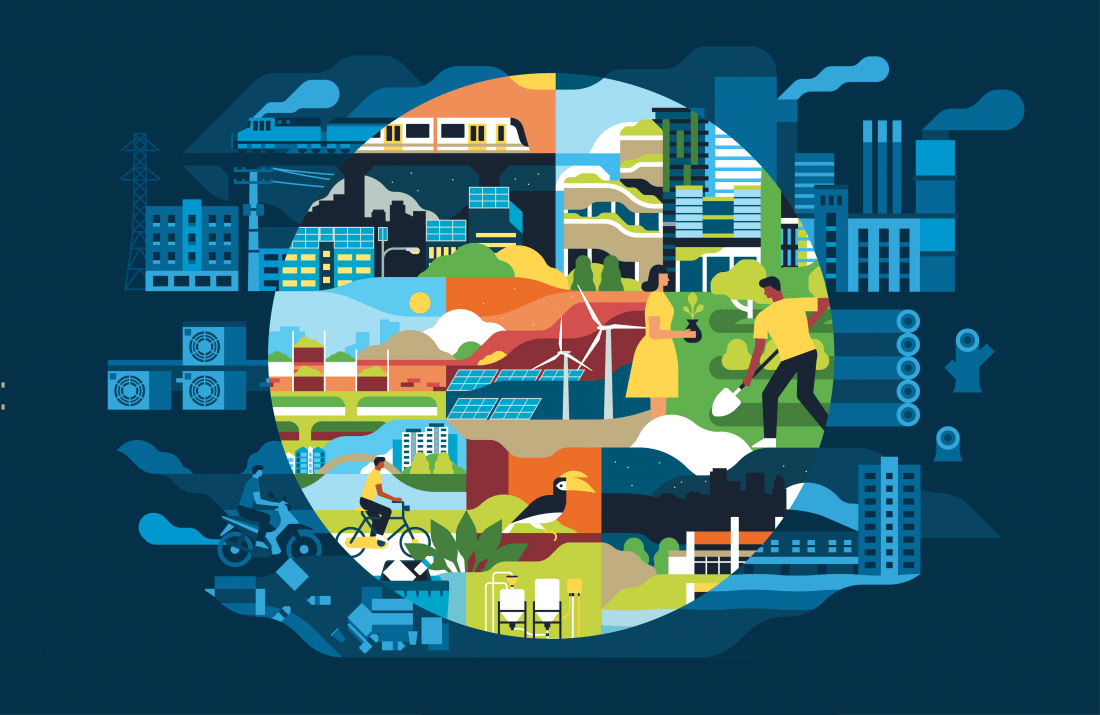
How smart infrastructure will make our cities safer, aid those in need and shorten your commute
July 30, 2021 | By Lim Kok KeeFrom Singapore to Seoul to Sydney, every city possesses a character of its own. But many of the infrastructure challenges of supporting a bustling urban population—especially in the midst of a pandemic—are universal.
Today, 4.2 billion people live in cities, driving more than 80% of the world’s GDP[1]. While disparity within cities was evident before, the pandemic has shone an even brighter spotlight on those inequalities. While the wealthiest have largely been able to maintain their standards of living, lower income residents have struggled with stressed healthcare systems, often inefficient aid delivery and urban infrastructure and economies that are straining to keep pace with the new COVID reality.
As local governments tackle these challenges, they are increasingly turning to technology for help. Adaptations, such as virtual services, dynamic analytics or contactless payment apps, will reshape how governments operate and interact with their constituents long after the pandemic subsides.
Insights gleaned from data will be the lifeblood that fuels the rise of new city infrastructure.
Giving Mobility a 21st Century Makeover
Before the pandemic, transit authorities in cities like Singapore, London and Dubai were already working to install touchless payment systems that eliminate the need for cash or physical tickets to change hands. The demand for these systems grew as cities tried to limit person-to-person contact to slow the spread of COVID-19. In India, this took shape as the One Mumbai Metro Card, launched recently in partnership with Mastercard, to enable safe, cashless, contactless transit journeys across the city, an effort that assumed even greater significance as the latest Covid wave hit the country.
With more people around the world tentatively returning to offices, schools and outings, cities need to do even more to restore traveler confidence—not just in the safety of buses and trains—but also in ride-hailing and shared mobility services. That might require adding trains or new bus routes to reduce overcrowding and better reflect how people’s work habits (and locations) have changed.
Many cities are also exploring solutions such as Mobility-as-a-Service which integrates the traveler journey across public and shared transportation to limit payment touchpoints. A journey can be managed end-to-end through a single gateway or portal, incorporating multiple public and private transport providers.
As more transit systems shift to digital payments, commuters and cities will reap the rewards. The same digital technologies that enable safer, low-contact transit in a public health crisis offer numerous benefits for a digital future. These include lowering operating costs or reducing crowding and bottlenecks, making city transit more pleasant and visitor-friendly, and providing the next-level convenience that people are starting to demand.
To Go Far, Go Together
Through City Possible™, a partnership initiative pioneered by Mastercard to make the world’s cities more inclusive and sustainable, we’ve seen how cities thrive when their governments collaborate with others. By co-creating with member cities, and leaders in business, academia and nonprofits, cities can more easily solve common urban challenges by learning from one another’s successes and failures, often saving valuable time and resources in the process.
For instance, we’ve teamed up with partner VU.CITY to help city officials use 3D visualization technology and data to map their cities in intricate detail, allowing them to manage their assets and visualize how future projects will change everything from city traffic to the look of a city skyline.[2] Closer to home, Singapore Tourism Board (STB) became the first national tourism organization to join the City Possible™ network to explore ways to use technology to transform the way the city-state engages with visitors as international travel gradually returns.
Similarly, Mastercard’s Recovery Insights initiative helps cities to accelerate economic recovery by providing anonymized, aggregated, data-driven information to help cities make informed decisions about allocating their resources to reach the areas and people most affected by COVID-19. In countries like Australia and Japan, Mastercard provides consumer and tourism spend analytics and insights to aid the understanding of market trends and to support industry development programs. Our analytical geolocation solutions can provide insights down to postcode or street grid levels of granularity for modeling economic, tourism or disbursement planning.
On the Horizon
Looking beyond the pandemic, city governments are starting to think big about how data can make their city more sustainable and inclusive. Recently, Subic-Clark Alliance for Development (SCAD), the agency overseeing economic development in the Luzon area of the Philippines, joined City Possible™, making it the third member from the ASEAN region after Thailand’s Digital Economy Promotion Agency (depa) and Singapore Tourism Board (STB). The move is part of an initiative to ensure that, as the local economy rapidly expands, the region can keep pace with demands that come with urbanization. For instance, the partnership is exploring ways to leverage technology and data to digitize local government units and enhance the agricultural supply chain. In another example, Mastercard worked with fintech GCash to help Makati City officials electronically disburse financial aid to over 90,000 citizens via a prepaid Makatizen card.
As governments strive to expand and improve e-services for their citizens, digitizing their payment infrastructure becomes a critical enabler of frictionless government experiences. Smart payment gateways can help governments to simplify the backend operations of their e-portals or services apps, allowing them to more efficiently work with vendors, streamline payment flows and enable omni-channel acceptance and tokenization. Mastercard has partnered with governments in Egypt, Nigeria and Pakistan to accelerate the development of digital government services by tapping into a range of digital solutions including Mastercard Payment Gateway Services. We are also engaging public and private sector stakeholders across Asia Pacific, in places like Australia, India and the Philippines, to support their digitization agendas. What’s more, technology can make government e-services even safer by adding cybersecurity solutions ranging from additional layers of fraud protection to ID verification to biometrics analysis to verify payment transactions.
With so many challenges and opportunities to tackle at once, the time for action is now. As devastating as the COVID-19 pandemic has been, in its wake we have the chance to rebuild smarter cities that better serve their residents for decades to come. Technology and partnerships will help get us there.
